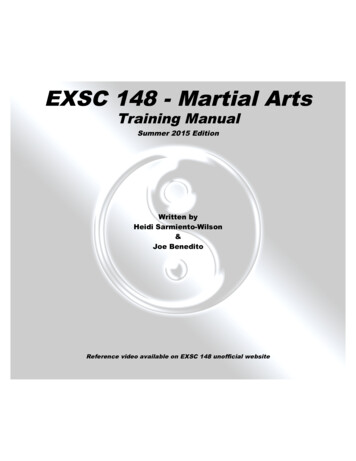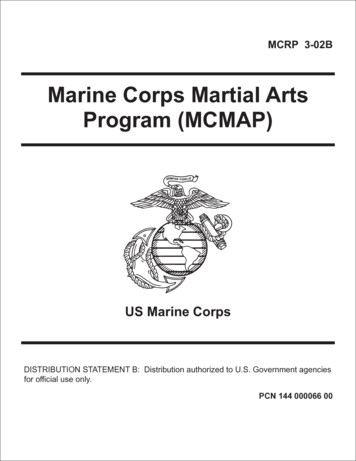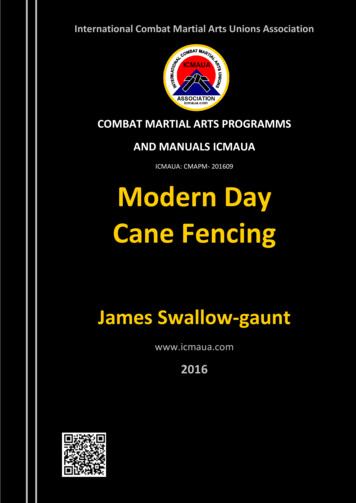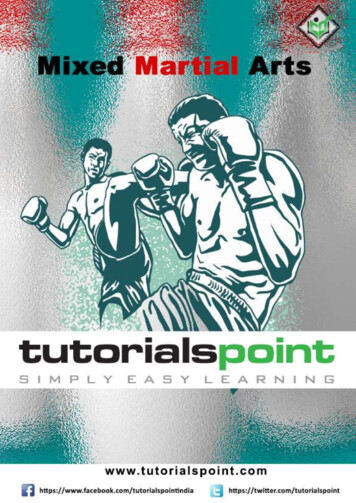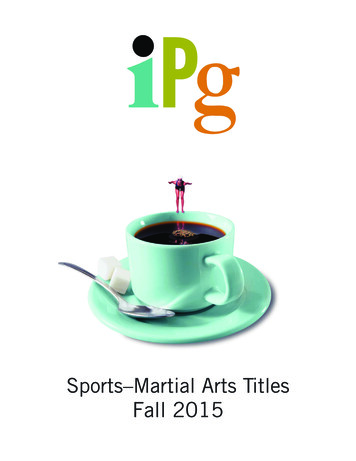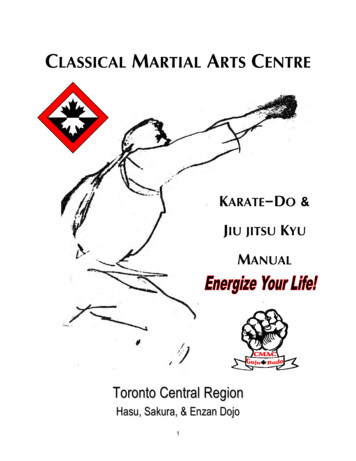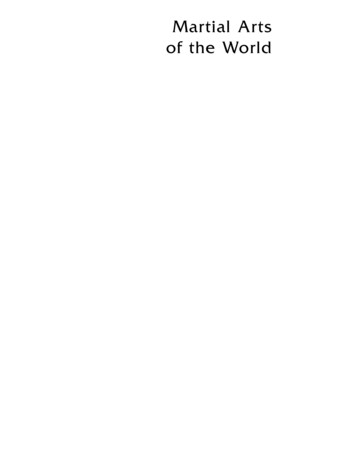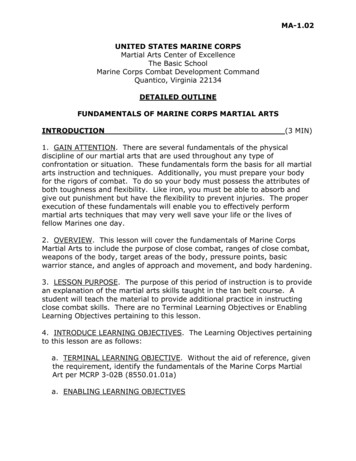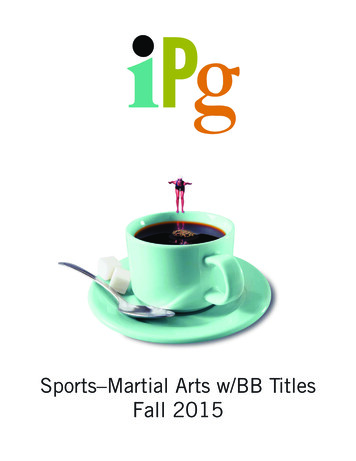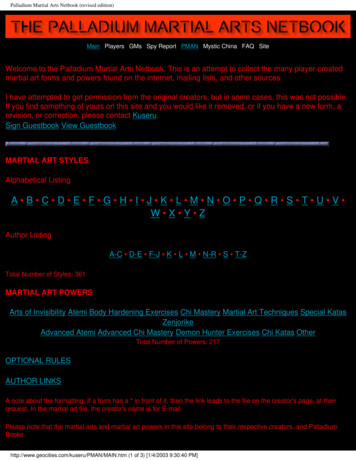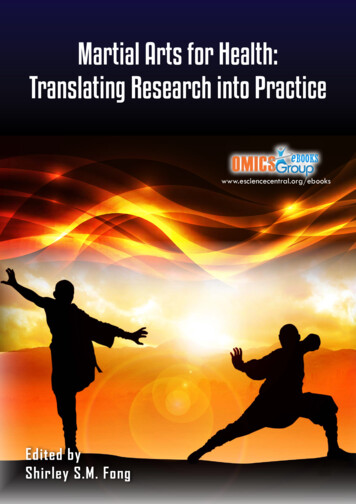
Transcription
Martial Arts for Health:Translating Research into PracticeEdited byShirley S.M. FongOMICS Group eBookswww.esciencecentral.org/ebooks001
Martial Arts for Health – Translating Researchinto PracticeAuthor: Shirley S.M. FongPublished by OMICS Group eBooks731 Gull Ave, Foster City. CA 94404, USACopyright 2014 OMICS GroupThis eBook is an Open Access distributed under the Creative Commons Attribution 3.0license, which allows users to download, copy and build upon published articles even forcommercial purposes, as long as the author and publisher are properly credited, whichensures maximum dissemination and a wider impact of our publications. However, userswho aim to disseminate and distribute copies of this book as a whole must not seek monetarycompensation for such service (excluded OMICS Group representatives and agreedcollaborations). After this work has been published by OMICS Group, authors have theright to republish it, in whole or part, in any publication of which they are the author, and tomake other personal use of the work. Any republication, referencing or personal use of thework must explicitly identify the original source.Notice:Statements and opinions expressed in the book are these of the individual contributors andnot necessarily those of the editors or publisher. No responsibility is accepted for the accuracyof information contained in the published chapters. The publisher assumes no responsibilityfor any damage or injury to persons or property arising out of the use of any materials,instructions, methods or ideas contained in the book.Cover OMICS Group Design teamFirst published February, 2014A free online edition of this book is available at www.esciencecentral.org/ebooksAdditional hard copies can be obtained from orders @ www.esciencecentral.org/ebooks
About EditorShirley Fong is an Assistant Professor in the Institute of HumanPerformance at the University of Hong Kong. She is also a registeredphysiotherapist in Hong Kong and a martial art coach. Regarding martial artqualifications, Shirley is black-belt and red/black-belt qualified in Karateand Taekwondo, respectively. In addition, Shirley is a Tai Chi and Ving Tsuninstructor. Being a researcher, therapist as well as a martial art coach,Shirley is particularly interested in research related to sports science andrehabilitation, complementary and alternative medicine (e.g., tai chi andqigong) and rehabilitation for children with disabilities using martial skills.
ContentsIntroductionChinese Martial Arts and HealthChapter 1: Internal Chinese Martial Arts- Tai ChiChapter 2: External Chinese Martial Arts and HealthKorean Martial Arts and HealthChapter 3: TaekwondoThai Martial Arts and HealthChapter 4: Muay ThaiWestern Martial Arts and HealthChapter 5: Western Boxing and HealthChapter 6: Wrestling and HealthChapter 7: Fencing and HealthPage #0507162227323942
Martial Arts for Health –Translating Research into PracticeShirley SM FongInstitute of Human Performance, The University of Hong Kong, HongKong*Corresponding author: Shirley SM Fong, Institute of HumanPerformance, The University of Hong Kong, Pokfulam, Hong Kong,Tel: (852)97090337; Fax: (852)28551712; E-mail: smfong@hku.hk &smfong 2004@yahoo.com.hkIntroductionMartial arts were developed for use on the battlefield in ancient times, and even in the modern world many people learn suchskills for self-defense [1]. Despite their combative nature, training in marital arts is safe compared with many other contact sports.The use of protective equipment such as mouth guards and headgear is mandatory during sparring, and practitioners must followstrict competition rules in many types of martial arts [2]. In addition, some types of martial arts such as Tai Chi and Qigong are noncombative in nature, with practitioners focusing on coordinated movements and relaxation during practice – all of which are beneficialto practitioners’ health [1,3].These days, the popularity of martial arts is increasing, particularly among young people [4]. There are about 200 distinct martialarts types or disciplines around the world, each with its own training characteristics and philosophy [5]. Only the most common typesof Oriental and Western martial arts and their associated health effects are introduced in this book. These martial disciplines include theinternal (e.g. Tai Chi and Qigong) and external (e.g. Choy Lee Fut and Shaolin Kung Fu) Chinese martial arts, Taekwondo, Thai Boxing,Western Boxing, Wrestling and Fencing. The following paragraphs provide a brief introduction to these arts.The Chinese Martial ArtsThe Chinese martial arts are believed to be the oldest in the world and there are many different styles ranging from ‘soft’ to ‘hard’.Most of the styles are linked to religions such as Taoism and Buddhism. Some Chinese martial arts practitioners use the yin/yang symbolto illustrate how power should be balanced with compassion and gentleness during practice, and this actually forms the foundation/training philosophy of these arts [5,6].TaekwondoTaekwondo, famous for its swift, high kicks, is a form of Korean martial art believed to be a modification and integration of theJapanese arts of Karate, Aikido, Judo and Kendo [6]. At present, there are two global Taekwondo organizations: the International andWorld Taekwondo Federations. The latter was largely responsible for the inclusion of this martial art as an Olympic sport [5].Thai BoxingThai Boxing, also known as Muay Thai, is the national sport of Thailand. It is a hard-fighting martial art and its practitionerskick and punch very hard during training and competitions. In addition, punches, kicks, knee strikes and elbow strikes are allowedduring matches. Although boxing gloves and groin guards are used, no other protective equipment is worn, making it one of the moredangerous of the traditional arts. More recently, a non-combat form of Thai Boxing called cardio kickboxing has been introduced inthe fitness industry to improve the physical fitness of the general population [6].Western BoxingBoxing is a common combat sport in the West and was first accepted as an Olympic sport in 688 BCE. Boxers fight each other usingvarious combinations of punching techniques [5]. It is similar to Thai Boxing, except that kicks, knee strikes and elbow strikes are notallowed during matches. There are two basic forms of Western boxing: amateur and professional. Only amateur boxers can compete inthe Olympic Games while only professional boxers can fight for money prizes [7].Wrestling is a grappling art commonly practiced at universities, colleges, high schools and middle schools in the United States.Emphasis is placed on learning how to control your opponent rather than executing explosive offensive techniques. During a match,a wrestler tries to pin down his opponent to score. This is a quite strenuous activity as the competitors are in constant motion. Boutsusually comprise three rounds [5].FencingFencing generally refers to the European style of swordsmanship and is now an Olympic sport. Olympic fencing uses an electronicscoring system to register the competitors’ scores and determine the winner. To score a point, competitors must touch their opponentwith the sword in a specific area. Fencing is a game of subtlety [5].OMICS Group eBooksWrestling005
Who should read this book?As mentioned above, each martial arts discipline has its own training characteristics and philosophy. Apart from a physical workout,some disciplines also emphasize spirituality. Therefore, the physical and psychological health benefits induced by martial arts trainingare undoubtedly discipline-specific [5,8]. This book provides an overview of the differential effects that practicing martial arts has on thepractitioners’ health. Parents and the general population should choose martial arts to suit their own or their children’s needs. Coachesand instructors in the fitness industry have some scientific evidence for promoting health through martial arts exercises. Health careprofessionals may wish to consider recommending martial arts to patients as a form of therapeutic exercise. Thus, the informationprovided in this book is useful for people of all ages and fitness levels from all walks of life.References1. Woodward TW (2009) A review of the effects of martial arts practice on health. Wisconsin Med J 108: 40-43.2. Pieter W (2005) Martial arts. In: D Caine, N Maffulli (eds.). Epidemiology of Pediatric Sports Injuries 59-73, Karger, Basel.3. Fong SSM, Ng SSM, Luk WS, Chung JWY, Ho JSC, et al. (2014) Effects of qigong exercise on upper limb lymphedema and blood flowin survivors of breast cancer: A pilot study. Integr Cancer Ther 13: 54-61.4. Yard EE, Knox CL (2007) Pediatric martial arts injuries presenting to emergency departments, United States 1990-2003. J Sci Med Sport10: 219-226.5. Crudelli C (2008) The Way of The Warrior – Martial Arts and Fighting Skills from Around the World. Dorling Kindersley Limited, New York.6. Mitchell D (1997) The Young Martial Arts Enthusiast. Dorling Kindersley Limited, London.7. The Diagram Group (1997) Boxing Skills – Brockhampton Diagram Guides. Diagram Visual Information Ltd., London.OMICS Group eBooks8. Bu B, Haijun H, Yong L, Chaohui Z, Xiaoyuan Y, et al. (2010) Effects of martial arts on health status: A systematic review. J Evid BasedMed 3: 205-219.006
Internal Chinese Martial Arts andHealth - Tai ChiWilliam WN Tsang*, Wings TY Loo, Chad WN Chan andRuth X LuDepartment of Rehabilitation Sciences, The Hong Kong PolytechnicUniversity, Kowloon, Hong Kong, China*Corresponding author: William WN Tsang, Department ofRehabilitation Sciences, The Hong Kong Polytechnic University,Kowloon, Hong Kong, China, Tel: (852) 2766 6717; E-mail: William.Tsang@polyu.edu.hkA Brief Introduction to Tai ChiThe concept of Tai Chi existed long before the establishment of Tai Chi Chuan. The term “Tai Chi” firstly appeared in the Book ofYi, a book on Chinese philosophy from over 3,000 years ago during the Zhou dynasty (1100–1221 BC). It recounts Tai Chi’s splittingfrom one point into two extremities, or “poles”. By that account, all change exists as a result of Tai Chi, which generates two oppositesin everything. Tai in Chinese means “vast and all-encompassing”, while Chi is “the ultimate or extreme point”[1], thus the concept ofTai Chi (“supreme ultimate”), in contrast with wuji (“without ultimate”) which describes the vastness of the universe. Tai Chi’s ideaof opposites influenced early traditional Chinese philosophies, including those of Taoism, Confucianism, yin/yang theory and themeridians of traditional Chinese medicine.The essential principles of Tai Chi are based on Taoist philosophy, which stresses the natural balance in all things and the need forliving in spiritual and physical accord with the patterns of nature. According to this philosophy, everything is composed of opposites,but they are entirely complementary. The elements of yin and yang work in a relationship which is in perpetual balance. Based onTaoism, change originates in the Ultimate, which generated the two spheres—Yin and Yang. Afterwards, all things and all creatureswere created. The sage used this theory to manage the flow of qi in the universe, including the circulation of the sun and the moonand other natural phenomena, all of which follow the motion of the universe. The sage taught people how to cultivate crops in theirproper seasons and transmitted other vital knowledge to the people. Meanwhile, there is also a miniature aura inside and surroundingeach person’s body that moves with the rhythm of the universe. The head is as round as heaven; the feet are as square as the earth; thetemperature of the abdomen is as warm as the spring and summer; the back is as hard as the autumn and winter. As the four seasonschange with time, the five internal organs of the body and the five normal human relationships in the Chinese ethical tradition allrespond to the concept of the five elements, the 24 hours in a day, the 12 months in a year, the 360 solar terms in a traditional Chineseyear. The entire concept emphasizes living with the motion and rhythm of the universe.Tai Chi ChuanTai Chi Chuan (TCC) (also spelled Taijiquan or Tai Chi Quan) is a martial art which has been practiced in oriental societies formany centuries. In English it is referred to simply as Tai Chi, the real origins of TCC are obscure. The more romantic and mysticalaccounts date back as far as the 15th, 12th or even the 8th century. Some prominent names are said to have been involved in its foundation.One is Chang San-Feng, a 13th century Taoist priest who is credited with developing an esoteric system combining techniques fromvarious pre-existing styles of martial arts with Taoist breathing techniques. Nowadays, most styles of TCC claim Chang San-Feng asthe founder.Although it is not possible to identify precisely when TCC was created or by whom, it was developed using theories of Chinesephilosophy like “the interchangeability of yin and yang” and taking into account the principles of body movement as well as breathing.A Tai Chi routine consists of a set patter of continuous movement involving between 82 and 150 postures, all regulated by yin/yangtheory. The entire set of movements should be gentle, continuous, circular and harmonious, accompanied by deep and regular breathingwhen executed.Tai Chi has developed over the centuries into many different styles, most bearing the family names of their originators. Mostmodern styles trace their developments to at least one of five traditional styles:Chen Wang-Ting (1600–1680), an army officer of the Ming dynasty, was deeply influenced by boxing techniques, particularly thestyle of Qi Ji-Guang. He selected 29 from among Qi’s 32 boxing postures and combined them with control of breathing to developseveral Tai Chi protocols including Five Routine TCC, 108 Form Long Fist and a more rigorous routine known as Cannon Fist. TheChen styles are characterized by including a motion termed Silk Reeling-slow and soft movements intermixed with bursts of power.Chen style is rich with combat techniques, which makes it more practical and effective for combat.Yang styleYang style is the most popular and most widely practiced worldwide today. Yang Lu-Shen (1799–1872) created Yang style in theearly 19th century. As a youth, Yang loved martial arts and studied with many famous masters, including Chen Chang-Hsing, who wasa very influential martial artist and teacher of TCC at that time. Yang eventually developed three major styles of TCC. Yang’s styles arecharacterized by gentle, steady and slow movements, but still maintain certain the martial arts overtones. Yang and his descendantshave made TCC more suitable for the general public and for promoting general health.OMICS Group eBooksChen style007
Wu (Hao) styleWu style, also known as Hao style, was created by Wu Yuxiang (1812–1880) and passed on to Hao Weizheng (1849–1920), whosignificantly contributed to the style’s development. This style is characterized by slow and internally loose movements which are closeknit in outward appearance. Great emphasis is placed on internal force and correct positioning. The motions of an expert performing theHao style appear large and well rounded, as though inner power were projected beyond the outward physical shape of the body.Wu styleWu Quan-you (1834–1902), and later his son Wu Jian-quan (1870–1942), created another Wu style (homophones distinguished bydifferent Chinese characters), which is characterized by softness and emphasis on redirecting incoming force. It has rich hand techniques.Wu style tends to have a slight forward leaning posture. The style is pleasant to look at and is rich in techniques.Sun styleSun style is the youngest of the major styles. It was created by Sun Lu-tang (1861–1932), a student of Hao Wei-zheng. Sun style ischaracterized by agile steps. Whenever one foot moves forward or backward, the other foot follows. Its movements flow smoothly like ariver, and there is a powerful qigong exercise whenever the direction changes.Tai Chi in all styles can be practiced easily without equipment. It is easily taught in groups or to individuals and regular practice isthought to facilitate a lifestyle which promotes wellness among both young and old. Practice of Tai Chi is intended to balance and soothethe emotions while strengthening the body.Tai Chi FundamentalsYin and yangAccording to the concept of yin and yang, all phenomena are shaped by the interaction of two opposite cosmic energies termedyin and yang. Yin represents the negative, the dark and the feminine, while yang is bright, positive and masculine. Their interaction isthought to maintain the harmony of the universe and to influence everything within it. Yin and yang are the roots of creation and at theroot of all things in the world. The well-known circle divided into two equal halves by a curved line symbolizes yin and yang (Figure 1)and is also used to describe Tai Chi. One half is black (yin) and the other white (yang). The white dot in the black area and the black dotin the white area represent the coexistence and unity of the opposites which form the whole. The curved line in the symbol suggests thatthere is no absolute separation of the opposites. Apart from Tai Chi, the symbol represents how yin and yang relate to the dual nature ofeverything in this world, and to duality, paradox, unity in diversity, flexibility and harmony [2].YinYangFigure 1: Yin and Yang.Coordinated breathingIn Tai Chi, proper breathing is an important element of technique. Breathing should be deep, slow, abdominal and well-regulated.This is important because the mind should concentrate with the head held upright, allowing the spirit to rise to the top of the head. At thesame time, energy should move down the body’s dan tien meridian, so the back should be straight even as it deviates from the vertical.The abdomen should be full of qi. The chest must be relaxed so the breathing will be smooth, slow and deep. This abdominal breathingshould be a natural and not a forced expansion of the abdomen. All movement and stillness in TCC should be combined with a naturalbreathing rhythm. Inhale, for example, while raising the left foot and stepping to the side, exhaling when placing it down again. Inhalewhile raising the arms, a yin movement, then exhaling while extending them and opening the palms, a yang movement coupled with ayang exhalation.OMICS Group eBooksAs Chang San-feng explained in his Treatise on Tai Chi Chuan, “The inherent energy or potential of action (movement) and inaction(serenity and stillness) is the mother of yin and yang.” Yin and yang have no absolute beginning, so action and inaction in TCC also donot have a beginning. Tai Chi provides the inherent energy needed to promote yin and yang to react each other. The root of yang is tinand the root of tin is yang. The same principle can be observed during TCC exercises-the movement and stillness have the same origin.We seek serenity and stillness in action, while seeking motion in stillness. Stillness and movement are opposites, and their relationship inTai Chi can be explained in terms of yin/yang theory. Movements are up and down, forward and backward, left and right. The oppositeof motion is stillness. In all this, yin and yang coexist. Therefore, there is neither absolute stillness nor movement in TCC. When there isapparent stillness and no action, there is still action within the body-controlled breathing and the movement of qi.008
Every movement in Tai Chi is dictated by the waist; the waist is said to be the leader of the body. It should be relaxed and loose,allowing the legs to provide a solid foundation for the rest of the body as it releases power. The waist is the primary storage site for all vitalenergy. Movements may lack force or power if there is weakness in the waist and legs. A leg bearing the body’s weight is termed “solid”.If one leg bears the body’s weight, that leg is solid, while the other is termed “empty”.In Tai Chi, outward, opening movements are described as the internal directing the external. Internal strength is transferred andexpressed in the motion. Inward movements are the external leading the internal. They guide the proper breathing, thus inducing internalexercise and the storage of internal strength. One opening movement and one closing movement accompanied by one exhalation and oneinhalation complete one respiratory cycle.Smoothness and continuityAll Tai Chi routines begin with stillness. The individual starts not with muscular force, but with inner energy and concentration. AllTCC movements are then performed with control of the inner force. This allows performing the routine in a smooth, relaxed way whichwill lessen tension and promote relaxation, which will in turn help concentration and clear thinking. That is the main characteristicdistinguishing TCC from other martial arts. There is smooth constant motion like a flowing fluid. This means that the movement ofthe feet and hands must be perfectly coordinated throughout. The hand movements must finish simultaneously with the shifting of theweight from one leg to the other.ConcentrationAs has been discussed, stillness and movement coexist in TTC as yin and yang coexist in the universe. While performing the actionsof a Tai Chi routine, seeking serenity (stillness) is a requirement. Action allows the mind to retreat into tranquility, because it is fullyconcentrated on one thing. Concentration on the routine means the mind is untouched by any other thought and becomes totallyabsorbed by stillness in movement. Performing TTC this way will lead to peace and serenity. Many researchers have reported that TTCtraining helps cultivate the habit of seeking a peaceful and calm mind, which can alleviate high blood pressure. Practice can become avehicle for meditation and relaxation, promoting spiritual well-being [3]. This can have significant health effects.In summary, TCC not only teaches how to move, it emphasizes the principles of collaborating with nature and the universe. PracticingTCC allows individuals to be calm and balanced, in addition to strengthening the physique. When people start to practice TCC, theyalready start to live harmoniously with the universe.Bio-physiological Effects of Tai ChiTCC has long been practiced worldwide for its health benefits and in an effort to extend the life span [4]. In addition to being a formof therapy for many diseases including traumatic brain injury, rheumatoid arthritis, diabetes and cancer, TCC could also a preventativemeasure.Neuro-rehabilitationStroke leaves many survivors with mental and/or physical disabilities. Similarly, injuries to the brain and common neural disorderssuch as Parkinson’s disease will lead to the loss of balance control. Rehabilitation aims to hasten and maximize recovery and help restoremovement and functional independence, leading to reintegration into community life.Prospective controlled clinical trials have shown positive effects among stroke survivors with neural patients who practice Tai Chi.Practice can improve balance control, mental health and general quality of life. Gatty and Woollacott [5] have suggested that TCCpractice might enhance neuromuscular responses, control of the ankle joints and balance by drilling neuromuscular mechanisms andstepping with a swinging leg. Their research employed repetitive exercises using TCC motor and biomechanical strategies, techniques,and postural elements. The results showed that balance-impaired older adults significantly improved their neuromuscular control ofthe ankle muscles during perturbed walking, with responses up to 50 milliseconds faster than before training. Reduced co-contractionof agonist and antagonist muscles and better muscle response organization were also found in those peoples who had received TCCtraining. Significant improvements on four clinical measures of functional balance were also found—functional reach, one-legged stancetime, tandem stance time and the timed up and go test.In addition to physical disability, stroke often leaves survivors with mental problems including memory loss, depression, disturbedsleep and cognitive deficits [6]. A study conducted by Taylor-Piliae [7] enrolled 28 subjects who were at least three months post-strokeand divided them into 2 groups. One attended group classes in Yang style TCC three times a week for 12 weeks, while the other receivedweekly phone calls along with written materials promoting community-based physical activity. The findings indicated that practicing TaiChi tended to improve physical health, mental health, depression, and sleep quality.Most studies [4,5,8–10] have focused on evaluating the physical and mental balance of stroke survivors, and most have revealedsignificant differences between the Tai Chi group and the control group. The alternating weight shifting and the concentration seem toprovide useful training for the nervous system, the skeletal muscles and the joints, promoting more flexible, balanced and harmoniousmovements. TCC may be useful as an effective group therapy in stroke rehabilitation and for the prevention of falls among the elderly.An ample number of studies have considered TCC as an effective aerobic exercise, demonstrating that TTC has potential benefitsfor patients with cardiovascular diseases. Aerobic exercise engages the major muscle groups so respiration increases and the heart raterises to between 50 and 80 percent of its (age–related) maximum [11]. The duration of exercise at this level should be a minimum of 20minutes and up to 60 minutes in order to achieve cardiovascular benefit. The exercise intensity of TCC is low to moderate, dependingon the training style, posture and duration. For example, in the classic Yang style with 108 postures, a training session typically consistsof 20 minutes of warm up (low back and hamstring stretching, gentle calisthenics and balance training), 24 minutes of practice, and 10minutes of cooling down. The intensity would not normally exceed 55% of maximum oxygen intake [12], and 56% to 70% of maximumheart rate [12-14]. Intensity is similar across different ages for each gender.Chang has shown a six-month cardiac rehabilitation program based on TCC is associated with improvements in the product of peakOMICS Group eBooksCardiovascular rehabilitation009
heart rate and blood pressure and in reserve peak rate-blood pressure product among patients with coronary artery disease (CAD). ATCC exercise program can lead to a better prognosis for cardiac events among such patients [15]. A decrease in systolic blood pressureof 15.6 mm Hg and in diastolic blood pressure of 8.8 mm Hg has been observed after 12 weeks of Tai Chi training [14]. Serum totalcholesterol decreased to 15.2 mg/dL and high-density lipoprotein cholesterol increased to 4.7 mg/dL. Liu has suggested that TCC exercisemight be an effective alternative to the traditional fitness training for patients who are in phase II and III cardiac rehabilitation programsbecause of its positive effects on the cardiovascular and musculoskeletal systems [16]. Various studies have documented TCC’s positiveeffects on the physiological functioning and quality of life (QoL) of patients with heart disease.Cancer rehabilitationCancer is a leading cause of death worldwide. In Hong Kong, altogether 26,390 new cancer cases and 13,076 deaths were registeredin 2010 [17]. Surgery, radiotherapy, and chemotherapy are traditional treatments for cancer patients. Radiotherapy and chemotherapyeradicate tumor cells, restricting their ability to grow or reproduce. Traditional treatment that destroys cancerous cells is not withoutside effects such as anemia, nausea, vomiting or diarrhea. Use of complementary therapies to alleviate the side effects of cancer therapyhas been steadily increasing over the past decade [18,19]. Cancer survivors have multiple needs related to physical deconditioning,cardiovascular disease risk, and psychological stress. TCC may be a form of complementary therapy which can provide physiological andpsychological benefits to cancer survivors.Besides its important role in improving the cardiovascular system, the relaxation, deep and regulated breathing and slow movementsof TCC may have additional benefits for the psychological health and symptoms of cancer patients. Currently, psychosocial supportis widely accepted as important for enhancing their self-esteem and health related quality of life (HRQL) [20-23]. HRQL comprisespsychological functioning, social adjustment, functional ability, and disease and treatment-related symptoms. Mustian’s research groupcompared the efficacy of TCC and psychosocial support therapy for improving HRQL and self-esteem among breast cancer survivors[20]. In that study, women diagnosed with breast cancer, who had completed treatment within the previous 30 months, were randomizedto receive either 12 weeks of TCC or just psychosocial support. The results showed that the TCC group exhibited improvements in HRQLand self-esteem while the psychosocial support therapy group exhibited declines. Similar improvements in HRQL have been found inother research [21] along with improvements in physical functioning, role limitations, social functioning and general mental health.The study team led by Fong has demonstrated TC Qigong’s ability to improve shoulder mobility, muscular strength and the overallquality of life of breast cancer patients who had received a mastectomy and chemotherapy and/or radiation [22]. This study involvedpracticing 18 Forms Tai Chi Internal Qigong over a period of at least six months. Good shoulder rotation is vital for many everydayactivities, but breast cancer patients may experience weakened shoulder internal rotators after a mastectomy due to pectoral nervedamage in the surgery, affecting their QoL [20–26]. Fong’s group fou
OMICS Group eBooks 005 Martial Arts for Health - Translating Research into Practice Introduction . internal (e.g. Tai Chi and Qigong) and external (e.g. Choy Lee Fut and Shaolin Kung Fu) Chinese martial arts, Taekwondo, Thai Boxing, Western Boxing, Wrestling and Fencing. The following paragraphs provide a brief introduction to these arts.
